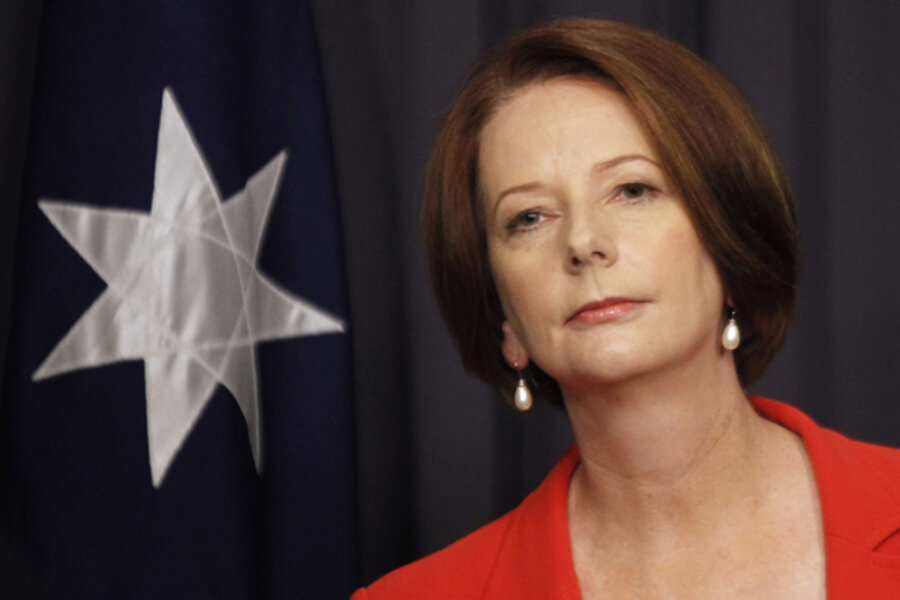Australia's first female prime minister keeps her job, for now
Loading...
| Sydney, Australia
Today Australia’s first female prime minister, Julia Gillard, won a leadership challenge by her predecessor, Kevin Rudd. The fight for the country's most senior political position has been one of Australia's most dramatic leadership battles Australia has known. Some analysts believe that sexism is at least partly to blame for Ms. Gillard's struggle.
“Julia Gillard has not done a bad job with a very difficult set of cards,” says Norman Abjorensen, a political scientist at the Australian National University (ANU). “But the way she’s been treated raises the question of whether Australians are prepared to accept a female head of government, and from what we’ve seen, we’ve got a long way to go.”
Gillard came to power in mid-2010 after deposing Mr. Rudd, who was trailing in the opinion polls. But she has been even less popular than him, and Rudd, who expressed anger at being ousted, challenged her for the leadership of the ruling Labor Party and role as prime minister. A vote Monday by Labor MPs, who elect the leader, resulted in 71 votes to Gillard and 31 to Rudd.
Ever since Gillard came to prominence as Labor’s deputy leader in 2006, attention has focused on her female attributes, or perceived lack of them. One newspaper profile featured her sitting in a spotless kitchen with an empty fruit bowl. She was quoted as saying she was “bloody hopeless” at cooking anything other than toast.
Attention also focused on the fact that she was unmarried, with no children. A parliamentary opponent accused her of being “deliberately barren.” After she became prime minister, her partner, Tim Mathieson, moved into the official Canberra residence with her. Her personal appearance – hairstyle, dress sense, even the length of her earlobes – were scrutinized even more closely and commented upon.
John Wanna, another ANU political expert, says there was a “huge groundswell of support” for Gillard initially, with many Australians delighted to have a woman in the top job. But she soon plummeted in the polls. While some of her policies – such as introducing a tax on carbon emissions – have been unpopular, and commentators say she failed to communicate them effectively, some believe she has been given a harder time because of being a woman.
When floods devastated the state of Queensland last year, for instance, Gillard was criticized for not showing enough emotion. Protesters who staged a demonstration in Canberra against the carbon tax waved banners stating: “Ditch the witch.” She was vilified for reneging on a campaign promise not to introduce the tax, with some critics branding her “Juliar.”
Male politicians have abandoned campaign promises without being so bitterly condemned, notes Professor Wanna. “I think going back on her word, and maybe this is a gender thing, really played badly for her,” he says. “People thought they could trust her because she was a woman. People don’t like a woman, in particular, lying.”
Perhaps most damaging, though, is the way she came to power, staging a coup against Rudd. Again, some analysts believe the public reaction has been harsher because of her gender. Christopher Pyne, an opposition politician, likened her to Lady Macbeth.
“The way she got to her position has made her more susceptible to being called things like [expletive] and ‘deceitful,’ which play into stereotypes of women,” says Lauren Rosewarne, a social scientist at the University of Melbourne. “These gender attributes have haunted her from day one.”
But Dr. Rosewarne does not believe that misogyny necessarily lies behind such attacks. “With attacks on politicians, people grasp for the easiest angle, and being a woman makes Gillard an easy target,” she says.
Gililard herself has avoided playing the sexism card. But in a television interview two weeks ago, she said Australians were “taking a bit of time” to get used to a female leader. Bob Brown, leader of the Australian Greens, was more blunt. “Quite a bit of the criticism is sexist and unfair and unrelenting, and the prime minister needs a bit of a break from that,” he said recently.
And Simon Benson, chief political correspondent of the Daily Telegraph, a Sydney tabloid, wrote in a blog that underlying the criticism was “a belief that the harder and more personal the attack, the more likely she is to break – because she is a woman.”
He went on: “With Gillard … there is a misogynistic tone which is driving the debasement of the political debate even further into the gutter.”
During the debates that preceded the election in 2010 one TV network gauged reactions by the public and there was clear negativity toward Gillard by men.
One other indicator of attitudes toward women is Australia's ongoing gender pay gap. Between 1990 and 2009, the gap stayed between 15 and 17 percent, according to the National Centre for Social and Economic Modelling. In August 2010, the Australian gender pay gap was 16.9 percent, according to the Australian government. Compared with Britain's pay gap, which was 9.1 percent in April 2010.
Rudd, who was elected in 2007, resigned as foreign minister last week in order to challenge Gillard. Although he is better liked by voters, most analysts doubted he could sway enough Labor MPs to win Monday’s ballot. Still, with Gillard highly unlikely to win the next election, due by late 2013, her days in the job are nonetheless numbered, analysts say.





